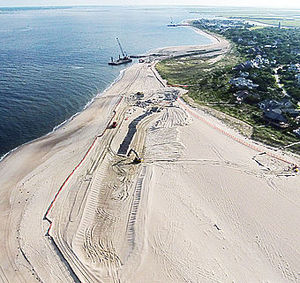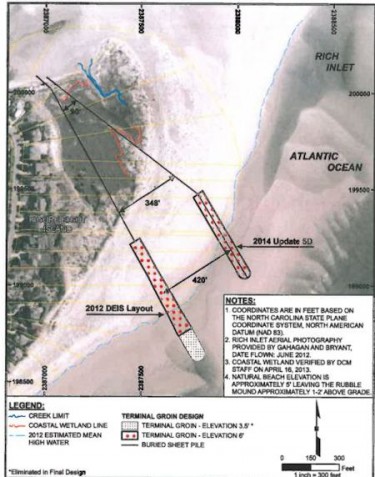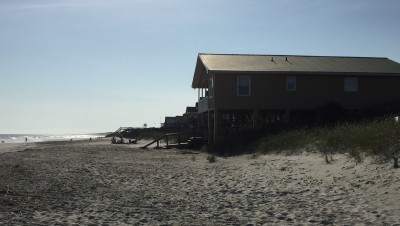First of two parts

More than 4,500 feet of new terminal groins could armor the southern N.C. coast within the next few years. That’s a wall of rock, concrete and metal to stretch more than triple the length of the longest Navy supercarrier.
Supporter Spotlight
Of the proposed terminal groin projects in North Carolina under federal review, the shortest is 750 feet long. The remaining projects are no less than 1,000 feet long.
All will jut from public beaches, span navigable waterways and, in some cases, cross private properties.
Since the General Assembly in 2011 repealed a decades-long ban on hardened erosion-control structures on the beach, terminal groins have been at the center of a debate about the potential effects man’s engineering will have on the state’s barrier islands.
Not everyone with a stake to claim agrees a terminal groin is best for their island. That is particularly true of some of the property owners who may be asked to grant land easements to their local governments for the purpose of building these controversial structures.
If even one property owner holds out, the process for a town and, in one case, a private island, could become mired in months, if not years, of legal battles, stalled permit applications and delayed construction.
Supporter Spotlight
There is also the issue of building on public property, an issue that is being overlooked in discussions about terminal groins, said Mike Giles, a coastal advocate with the N.C. Coastal Federation.
“These groins, some of them are proposed to be anchored on private property, but they extend on public recreational beaches,” he said. “Does everybody in North Carolina agree on putting these rock structures on public property? They would be not only on public beach but in public waters. They keep saying these terminal groins will be buried, that you won’t see them. I don’t believe them. You can go to Oregon Inlet and see the structure there. For the applicant to say there’s not going to be a negative effect on these beaches, it’s incorrect.”
Bald Head Island

The anchor of newly built terminal groin at the Village of Bald Head Island is buried and future maintenance of the structure should ensure it stays that way, the village administrator said.
Bald Head Island is the first North Carolina beach town to build a terminal groin since legislators repealed the law in 2011 and allowed up to four structures to be built along the coast. During the legislative session last year, lawmakers upped the number to six.
The Bald Head project received state and federal permits to build up to a 1,900-foot-long terminal groin and did not require any easements to private property.
The first phase of Bald Head’s terminal groin – 1,300 feet long – was finished in early January.
“The idea is that we monitor it,” said Chris McCall, the island’s manager. “At a minimum, it might take two to three years if there’s going to be a need for phase two. We just really would like to sit back and monitor the performance of it. Once we get some actual data that supports it’s working we could certainly weigh in more. We’re only asking to try and correct a man-induced problem with an engineered design.”
Bald Head Island has for years dealt with its erosion-embattled south and west beaches where chronic sand loss increased with the widening and deepening of the entrance to the Wilmington Harbor channel.
McCall said 99 percent of the island’s property owners understood the need for a terminal groin as part of the village’s long-term beach maintenance plan, “so there wasn’t any real pushback,” he said.
In 2014, village voters overwhelmingly passed an $18 million bond to secure funding for the project.
The village did not have to obtain private property easements on which construction crews would need to access to build the terminal groin and no portion of the structure is on private land.
The location of the second phase of the project, should the village opt to add on another 600 feet, would primarily be in the water, McCall said.
Figure Eight Island

That will not be the case for Figure Eight Island, whose homeowners’ association’s board of directors wants to build a 1,500-foot-long terminal groin at the northern end of the private island in New Hanover County.
Figure Eight was the first community in the state to submit a draft Environmental Impact Statement, or DEIS, selecting a preferred location of its proposed terminal groin to the U.S. Army Corps of Engineers in 2012.
Pressed by environmental groups, the Corps last year released a supplement to the draft study after the homeowners’ board submitted a preferred design and location different from what was included in the original DEIS.
The new design calls for the structure to be 420 feet farther north of the alternatives listed in the original study.
The decision to move the proposed structure, according to some property owners opposed to the project, was made so the board would not have to obtain easements from homeowners who indicated they would refuse to grant easements to their properties.
Figure Eight is unincorporated, and the homeowners’ association doesn’t have the legal authority to condemn property.
The HOA board will need anywhere from 12 to upwards of 15 property easements.
“The number will be determined once the final location has been permitted and determined through the EIS,” said David Kellam, Figure Eight Island administrator. “Obviously, the terminal groin in its general location and general elevations has been engineered in preliminary forms. I’ve not looked in a long time into the actual number that we would be proposing to pursue in getting easements for. We are certainly waiting until we know the facts of the (final) EIS so that we’re not asking somebody to grant an easement without knowing for certain that we’ll need that easement.”
Holden Beach

According to information in the DEIS of Holden Beach’s proposed terminal groin project, it appears the 1,000-foot-long structure would cross two private properties.
Beachfront properties have actually accreted within the gated neighborhood of Dunescape at the far eastern end of the island where about 300 feet of the proposed terminal groin would be anchored on the shore.
The beachfront just below where the sand buildup has occurred has had chronic erosion problems for decades. What were once second-row beach homes on McCray Street sit on the oceanfront.
Holden Beach officials have said they do not think the proposed project will require property easements.
They are waiting for the final EIS to be released later this year before determining if easements will be necessary. Town officials have also not determined how to pay for the 30-year project.
The proposed $34.4 million project has its fair share of skeptics, including property owners and town commissioners who question whether a terminal groin will benefit the entire island or merely a handful of properties.
Ocean Isle Beach
Holden Beach’s neighboring barrier island immediately to the west, Ocean Isle Beach, is already is the process of gathering dozens of property easements for its proposed terminal groin project.
“We’re not looking at acquiring any private property,” said Town Administrator Daisy Ivey. “We’re looking at obtaining easements for the construction of the terminal groin and then maintaining it.”
The town earlier this year mailed out requests for 50 property easements it needs to access the construction site for the terminal groin and for future sand nourishment projects associated with the structure.
The town has to have the easements prior to applying for a Coastal Area Management Act major permit.
“We’re hoping to get it (the permit) in and approved to be able to go to construction this year if possible,” Ivey said.
Tuesday: Will town condemn needed property?







